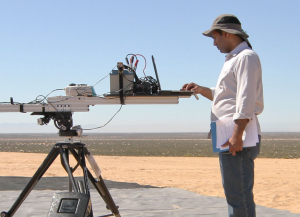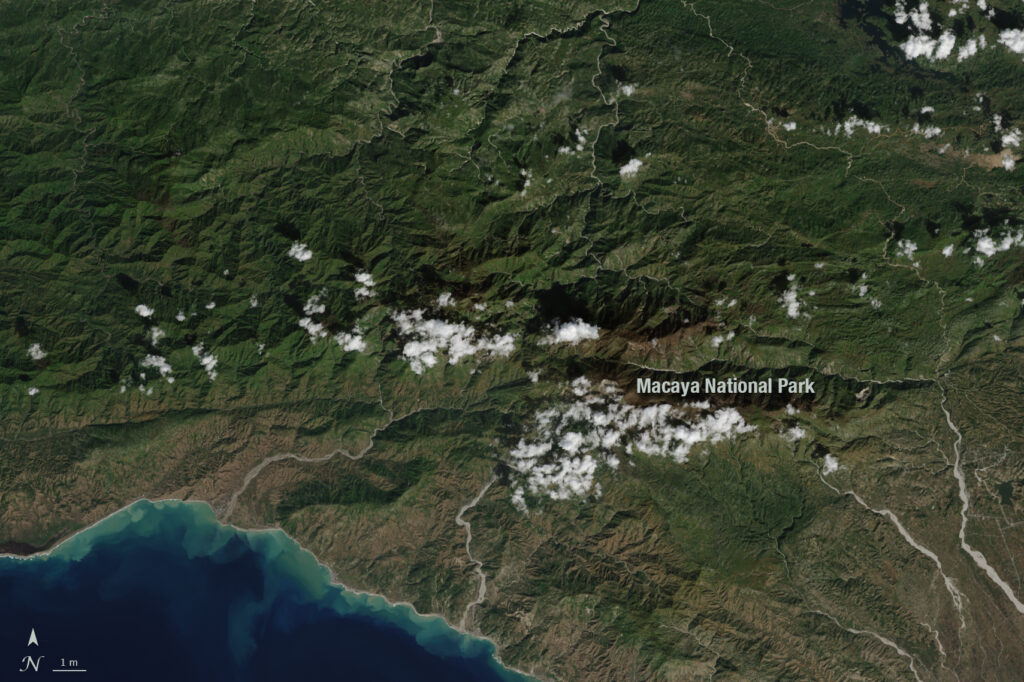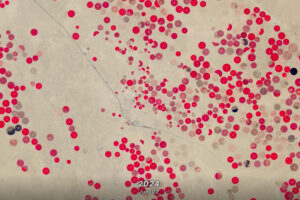[By Larisa Serbina and Colin Leslie USGS Fort Collins Science Center] Landsat is a key data input for many products developed and used in water resources, agricultural monitoring, land use and land cover monitoring, forest management, and development planning. Yet, Landsat’s contribution goes beyond its use solely as a primary data input. The products and processes developed by the Landsat program provide tools for data accuracy and visual communication improvement of other satellite imagery. These products are provided by the Landsat program at no cost to the users and have proven to be valuable assets to the private tech sector. This case study explores that various correction capabilities that Landsat offers to other satellite operators, acting as a tool in improvement of usability of other imagery. Several satellite companies and satellite imagery users are highlighted as beneficiaries of Landsat products.
Landsat: Base Layer
A base layer is a data set used as a reference for the display, analysis or correction of other data. Imagery, such as from Landsat and Landsat-like satellites is often used as a base layer. As a base layer, Landsat imagery is particularly helpful for verifying the accuracy of data due to the high quality of geometric correction and orthorectification of Landsat Level 1T data. Frank Warmerdam of Planet Labs[1], a company that designs, builds and operates network of small satellites, notes that Landsat’s high quality scenes provide a “trusted global basemap” for public and private sector use. Mapbox creates custom maps with open source tools and uses Landsat imagery as a basemap for a wide range of moderate resolution products (Charlie Loyd, Mapbox, written commun. and oral commun., 2014). DigitalGlobe, a satellite imagery provider, is another user of Landsat imagery. As DigitalGlobe’s data archive continues to grow, their use of Landsat imagery will likely be declining. However, the company used Landsat imagery to get started with their “DigitalGlobe Basemap” product series. Landsat data are also used by DigitalGlobe in parts of the world where either no high resolution data or no recent high resolution data is available (Walter Scott, DigitalGlobe, written commun., 2014).
Processing satellite data using Landsat

A vast amount of processing is required to take the raw imagery collected by satellites and translate it into usable data for analysis. Spatial and spectral corrections are necessary in order to accurately locate the imagery on the earth’s surface and convert pixel values to meaningful measures of the surface being captured. The Landsat program offers state of the art technology and methodology for conducting these corrections and as a result provides trusted remotely sensed data set for global coverage at the moderate resolution level. Due to Landsat’s high standards and well documented approaches to spatial and spectral corrections, the correction and calibration of other satellite imagery can be achieved through the use of Landsat imagery.
Spatial Correction
Spatial correction, sometimes referred to as geo-rectification, geo-registration or spatial tie-down, involves accurately locating imagery on the earth’s surface as well as correcting for distortions in the image through geometric correction and orthorectification. Geometric correction requires assigning known coordinates to points in the image, which geolocates the image to the correct place on the Earth’s surface. Additionally, it corrects for large scale distortion or error inherent in image due to earth movement, earth curvature, and/or satellite movement during collection. Correcting small scale distortion is done through orthorectification, a type of geometric correction that utilizes digital elevation data to more accurately correct for distortions due to terrain (Tucker, Grant, and Dykstra 2004).
The capability of Landsat to assist in spatial correction of other satellite data is utilized by companies such as DMCii, Planet Labs and BlackBridge. DMCii, a satellite imagery provider, uses Landsat data as a base layer for providing orthorectification for customers who do not have their own reference data, which is most of their customer base. This helps keep the costs down while improving the accuracy of DMCii’s products (Steve Mackin, DMCii, written commun., 2014). Planet Labs uses Landsat for the spatial tie down process everywhere around the globe for consistency and convenience. However, when processing difficult areas such as jungles and mountains, Landsat is a particularly critical resource. “Without Landsat it would be essentially impossible to get good Ground Control Points (GCP) locations from other sources,” says Frank Warmerdam of Planet Labs. Similarly, BlackBridge, Canada’s foremost supplier of satellite imagery products, is using Landsat imagery to perform geometric correction and orthorectification on areas in northern Africa and eastern Asia, where no better GCP’s are available. BlackBridge has been using Landsat GCP since 2009 on about 750,000-800,000 out of 1 million products. The company will likely continue to use Landsat GCP’s until higher accuracy GCP’s become available for the rest of the landmass on earth (Andreas Brunn, BlackBridge, written commun., 2014).
Spectral Corrections
Another important component of imagery processing is spectral correction. Spectral correction includes spectral characterization and radiometric calibration. Spectral characterization is a process of determining how different portions of the electromagnetic wavelength interact with an object. Radiometric calibration is a broader term for the process of relating values recorded (sensed) by a satellite sensor with radiance values (what was actually reflected/emitted on the ground). Calibration can either be absolute or relative and can employ different methods depending on when in the process the calibration is being performed.
For radiometric calibration, cross-calibration and surface reflectance are the principle processes used to correct satellite imagery. Cross-calibration is a form of relative calibration which compares values collected by one satellite sensor against values collected by a second satellite sensor. If one of the sensors has had corrections applied, the corrected values can be used for relative radiometric calibration of the other sensor. This method can be a cost effective method for radiometric calibration of operational satellites (Liu et al. 2004). DMCii initially used Landsat 7 as a standard reference satellite for cross-calibration over Libya and Antarctica. The company is now working on incorporating Landsat 8 data, which produces a good long term baseline for cross-calibration. In the future, DMCii anticipates incorporating data from the European Union Sentinel-2 mission into their tool kit.
For certain analyses of satellite imagery, it is necessary to calibrate for surface reflectance, which is the ratio of solar energy that is reflected rather than absorbed by an object on the earth’s surface. However, the reflected energy must first pass back through the atmosphere before it is detected by the satellite sensor. As a result, corrections must be applied to remove atmospheric effects. Landsat currently uses a set of algorithms known as the Landsat Ecosystem Disturbance Adaptive Processing System (LEDAPS). This type of radiometric calibration uses auxiliary data including ozone, water vapor, geopotential height, and aerosol optical thickness to calculate surface reflectance (“USGS Q&A: Adding Value to Landsat Imagery with LEDAPS” 2014). Once these corrections are applied, surface reflectance products represent what radiance values would be under ideal conditions (i.e., no atmospheric effects). Many higher-level surface geospatial analyses—including vegetation indexes, albedo, Leaf Area Index (LAI), burned area, land cover, and land cover change – rely on surface reflectance products. The availability of these products in the private sector is highly valued by the users.
Mapbox reports that of all the atmospheric correction methods tested by them, LEDAPS is the one they trust most. “LEDAPS allows types of comparison and analyses that would otherwise require significant single-purpose investments. We estimate that LEDAPS has saved our company approximately $250,000 in technical and opportunity costs over the last 24 months, and that number is steadily increasing,” says Charlie Loyd, a member of Mapbox’s satellite team. “Other than its accuracy, the key to LEDAPS’s value to us is its generality. We can apply LEDAPS to a Landsat scene once and have output that’s equally appropriate for true color imagery, classification algorithms, NDVI, and other indexes. We recommend it broadly, knowing that it will meet virtually any user’s needs for atmospheric correction. For these reasons, LEDAPS is the only non–in-house component of our Landsat software pipelines that we consider effectively irreplaceable.”
DigitalGlobe is another company that has accrued benefits through LEDAPS. The company sees Landsat as a key input in the development process of their own surface reflectance product. In 2013, DigitalGlobe introduced a new product, seamless country-scale orthomosaics at half meter resolution, using Landsat for surface reflectance to bootstrap to a base map. DigitalGlobe reports that having Landsat data available accelerated the introduction of the product by about 9 months. While the company does not break out revenue by product in their public reporting, this particular product represents multiple millions of dollars of revenue annually.
Additional Benefits
In addition to the more specific spatial and spectral correction benefits discussed above, the Landsat program as a whole offers additional benefits to the private satellite imagery community. According to Frank Warmerdam of PlanetLabs, the Landsat archive acts as a common reference point among datasets, where the well-published and respected nature of Landsat products provides a reference for product to product relation. Along with Landsat’s long continuous data record and exceptional technical integrity, it is made indispensable by its free distribution (Charlie Loyd, Mapbox, written commun., 2014). The free and open access to the Landsat current and archived data enables private companies to improve their products at minimal cost, while developing additional products to push to the market.
Any use of trade, firm, or product names is for descriptive purposes only and does not imply endorsement by the U.S. Government.
References
Liu, J.-J.; Li, Z.; Qiao, Y.-L.; Liu, Y.-J.; and Zhang, Y.-X., 2004, A New Method for Cross-Calibration of Two Satellite Sensors: International Journal of Remote Sensing, v. 25, no. 23, p. 5267–5281 accessed October 1, 2014 at http://www.tandfonline.com/doi/abs/10.1080/01431160412331269779.
Tucker, C.J., Grant, D.M., and Dykstra, J.D., 2004, NASA’s Global Orthorectified Landsat Data Set: Photogrammetric Engineering & Remote Sensing, v. 70, no. 3, p. 313–322, accessed September 30, 2014 at http://essential.metapress.com/index/5130676X3531477G.pdf.
Herwig, Chris, 2014, USGS Q&A-adding value to Landsat imagery with LEDAPS: Mapbox’s Blog, January 16, 2014, accessed October 2, 2014 at https://www.mapbox.com/blog/ledaps-for-better-landsat-imagery/.






